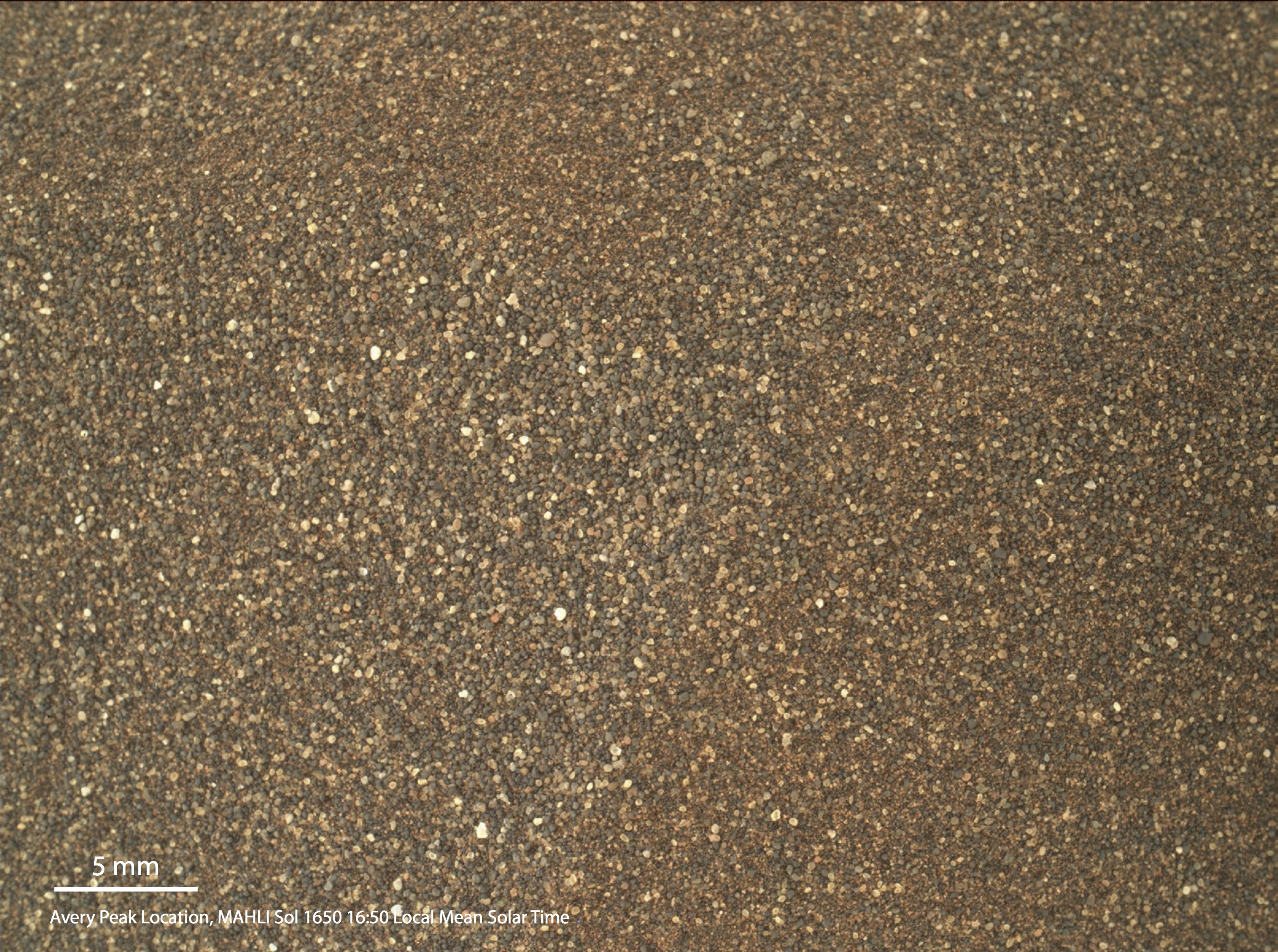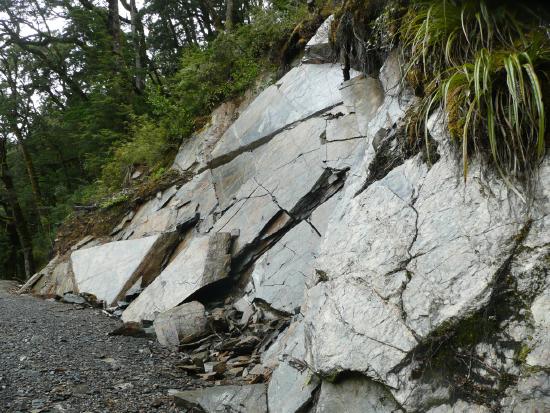1.7: 7. Weathering and Erosion
- Page ID
- 1394
\( \newcommand{\vecs}[1]{\overset { \scriptstyle \rightharpoonup} {\mathbf{#1}} } \)
\( \newcommand{\vecd}[1]{\overset{-\!-\!\rightharpoonup}{\vphantom{a}\smash {#1}}} \)
\( \newcommand{\id}{\mathrm{id}}\) \( \newcommand{\Span}{\mathrm{span}}\)
( \newcommand{\kernel}{\mathrm{null}\,}\) \( \newcommand{\range}{\mathrm{range}\,}\)
\( \newcommand{\RealPart}{\mathrm{Re}}\) \( \newcommand{\ImaginaryPart}{\mathrm{Im}}\)
\( \newcommand{\Argument}{\mathrm{Arg}}\) \( \newcommand{\norm}[1]{\| #1 \|}\)
\( \newcommand{\inner}[2]{\langle #1, #2 \rangle}\)
\( \newcommand{\Span}{\mathrm{span}}\)
\( \newcommand{\id}{\mathrm{id}}\)
\( \newcommand{\Span}{\mathrm{span}}\)
\( \newcommand{\kernel}{\mathrm{null}\,}\)
\( \newcommand{\range}{\mathrm{range}\,}\)
\( \newcommand{\RealPart}{\mathrm{Re}}\)
\( \newcommand{\ImaginaryPart}{\mathrm{Im}}\)
\( \newcommand{\Argument}{\mathrm{Arg}}\)
\( \newcommand{\norm}[1]{\| #1 \|}\)
\( \newcommand{\inner}[2]{\langle #1, #2 \rangle}\)
\( \newcommand{\Span}{\mathrm{span}}\) \( \newcommand{\AA}{\unicode[.8,0]{x212B}}\)
\( \newcommand{\vectorA}[1]{\vec{#1}} % arrow\)
\( \newcommand{\vectorAt}[1]{\vec{\text{#1}}} % arrow\)
\( \newcommand{\vectorB}[1]{\overset { \scriptstyle \rightharpoonup} {\mathbf{#1}} } \)
\( \newcommand{\vectorC}[1]{\textbf{#1}} \)
\( \newcommand{\vectorD}[1]{\overrightarrow{#1}} \)
\( \newcommand{\vectorDt}[1]{\overrightarrow{\text{#1}}} \)
\( \newcommand{\vectE}[1]{\overset{-\!-\!\rightharpoonup}{\vphantom{a}\smash{\mathbf {#1}}}} \)
\( \newcommand{\vecs}[1]{\overset { \scriptstyle \rightharpoonup} {\mathbf{#1}} } \)
\( \newcommand{\vecd}[1]{\overset{-\!-\!\rightharpoonup}{\vphantom{a}\smash {#1}}} \)
\(\newcommand{\avec}{\mathbf a}\) \(\newcommand{\bvec}{\mathbf b}\) \(\newcommand{\cvec}{\mathbf c}\) \(\newcommand{\dvec}{\mathbf d}\) \(\newcommand{\dtil}{\widetilde{\mathbf d}}\) \(\newcommand{\evec}{\mathbf e}\) \(\newcommand{\fvec}{\mathbf f}\) \(\newcommand{\nvec}{\mathbf n}\) \(\newcommand{\pvec}{\mathbf p}\) \(\newcommand{\qvec}{\mathbf q}\) \(\newcommand{\svec}{\mathbf s}\) \(\newcommand{\tvec}{\mathbf t}\) \(\newcommand{\uvec}{\mathbf u}\) \(\newcommand{\vvec}{\mathbf v}\) \(\newcommand{\wvec}{\mathbf w}\) \(\newcommand{\xvec}{\mathbf x}\) \(\newcommand{\yvec}{\mathbf y}\) \(\newcommand{\zvec}{\mathbf z}\) \(\newcommand{\rvec}{\mathbf r}\) \(\newcommand{\mvec}{\mathbf m}\) \(\newcommand{\zerovec}{\mathbf 0}\) \(\newcommand{\onevec}{\mathbf 1}\) \(\newcommand{\real}{\mathbb R}\) \(\newcommand{\twovec}[2]{\left[\begin{array}{r}#1 \\ #2 \end{array}\right]}\) \(\newcommand{\ctwovec}[2]{\left[\begin{array}{c}#1 \\ #2 \end{array}\right]}\) \(\newcommand{\threevec}[3]{\left[\begin{array}{r}#1 \\ #2 \\ #3 \end{array}\right]}\) \(\newcommand{\cthreevec}[3]{\left[\begin{array}{c}#1 \\ #2 \\ #3 \end{array}\right]}\) \(\newcommand{\fourvec}[4]{\left[\begin{array}{r}#1 \\ #2 \\ #3 \\ #4 \end{array}\right]}\) \(\newcommand{\cfourvec}[4]{\left[\begin{array}{c}#1 \\ #2 \\ #3 \\ #4 \end{array}\right]}\) \(\newcommand{\fivevec}[5]{\left[\begin{array}{r}#1 \\ #2 \\ #3 \\ #4 \\ #5 \\ \end{array}\right]}\) \(\newcommand{\cfivevec}[5]{\left[\begin{array}{c}#1 \\ #2 \\ #3 \\ #4 \\ #5 \\ \end{array}\right]}\) \(\newcommand{\mattwo}[4]{\left[\begin{array}{rr}#1 \amp #2 \\ #3 \amp #4 \\ \end{array}\right]}\) \(\newcommand{\laspan}[1]{\text{Span}\{#1\}}\) \(\newcommand{\bcal}{\cal B}\) \(\newcommand{\ccal}{\cal C}\) \(\newcommand{\scal}{\cal S}\) \(\newcommand{\wcal}{\cal W}\) \(\newcommand{\ecal}{\cal E}\) \(\newcommand{\coords}[2]{\left\{#1\right\}_{#2}}\) \(\newcommand{\gray}[1]{\color{gray}{#1}}\) \(\newcommand{\lgray}[1]{\color{lightgray}{#1}}\) \(\newcommand{\rank}{\operatorname{rank}}\) \(\newcommand{\row}{\text{Row}}\) \(\newcommand{\col}{\text{Col}}\) \(\renewcommand{\row}{\text{Row}}\) \(\newcommand{\nul}{\text{Nul}}\) \(\newcommand{\var}{\text{Var}}\) \(\newcommand{\corr}{\text{corr}}\) \(\newcommand{\len}[1]{\left|#1\right|}\) \(\newcommand{\bbar}{\overline{\bvec}}\) \(\newcommand{\bhat}{\widehat{\bvec}}\) \(\newcommand{\bperp}{\bvec^\perp}\) \(\newcommand{\xhat}{\widehat{\xvec}}\) \(\newcommand{\vhat}{\widehat{\vvec}}\) \(\newcommand{\uhat}{\widehat{\uvec}}\) \(\newcommand{\what}{\widehat{\wvec}}\) \(\newcommand{\Sighat}{\widehat{\Sigma}}\) \(\newcommand{\lt}{<}\) \(\newcommand{\gt}{>}\) \(\newcommand{\amp}{&}\) \(\definecolor{fillinmathshade}{gray}{0.9}\)Weathering
Sediment comes from the break down of rocks into smaller, transportable components. This occurs via two processes: physical weathering and chemical weathering. Physical weathering consists of breaking apart rocks and crystals. The results of physical weathering are smaller components of the same material that is being weathered. There is no change in composition. In contrast, chemical weathering consists of changing the composition of at least some components of the rock that is weathering. The sediment does not have the same composition as the original rock.
Physical Weathering
Physical weathering occurs via:
- Freeze-thaw action. Water in cracks expands when it freezes, putting force on the cracks. The cracks grow, and eventually crystals and pieces of rock break off into smaller components. Obviously, this process is most important in environments where temperatures cycle across the freezing point of water.
- Salt crystal growth. When water evaporates, salts precipitate. If this happens in fractures in rock, the growth of the salt crystals can put pressure on the cracks, causing them to grow. This process is most important near oceans where rocks are exposed to lots of salt water spray and in arid environments where water evaporates rapidly.
- Temperature changes. Minerals contract and expand as temperature decreases and increases, respectively, and different parts of the rock are heated different amounts. Those in direct sunlight expand as they heat, whereas the interiors and shaded areas do not. Differential expansion and contraction produces stresses which can result in cracks and physical weathering. This process is most important when temperatures change dramatically from day to night, a characteristic of many desert environments.
Physical weathering tends to produce mostly sand-sized sediment and larger grains because most of the fracturing occurs along mineral boundaries. Physical weathering of fine grained or finely crystalline rock can produce abundant very fine grains, but most of the sediment from these rock types consists of rock fragments (called lithic clasts).
Image of physically weathered rocks in New Zealand:
Chemical Weathering
Chemical weathering occurs via:
- Dissolution of minerals. Some minerals like halite and other evaporites dissolve very easily in water. Other minerals, particularly silicates, do not dissolve easily. Carbonates are in between and dissolve in acidic waters. (Rain water has a pH of ~5.7 due to dissolved CO2, even without “acid rain” pollution.) The results of dissolution are ions in water that are transported downstream. Ions are not deposited until the water evaporates, they react with other minerals, or organisms use them to make shells. Often, only part of a rock dissolves, leaving altered grains that can be transported by wind, water, etc.
- Alteration of minerals. Silicate minerals do not dissolve very easily, but they do react with water to form new minerals. Feldspars react with water to form clay minerals and ions, olivine reacts with water and O2 to form oxides, clay minerals and ions, pyrite reacts with water and O2 to form oxides, acidity and sulfate ions. Iron oxides, such as hematite, are commonly red, giving weathered rocks a rusty hue. Alteration of minerals is one of the main sources of clay minerals and mud-sized grains.
Image of chemically weathered rocks in New Zealand. This outcrop originally had the same composition as the rock shown in the previous photograph, but has been exposed to much more water as well as plant-assisted soil processes.
Mineralogy of Weathered Rocks
Sediments that have been subjected primarily to physical weathering have a mineralogy that is similar to that of the parent rock. If the sediments have been subject to extensive chemical weathering, it is much harder to characterize the source rocks because the composition has changed extensively. Overall, the composition of sediment depends on the mineralogy of the original rock, how it is transported, and the weathering environment.
Some minerals alter more quickly than others. Quartz is difficult to dissolve and is hard, so it commonly lasts through both chemical and physical weathering and is the most common mineral in sand on Earth. In contrast, minerals like Ca-feldspar and olivine react to form new minerals quickly. They are substantially less common in sediments. Thus, mafic rocks (which contain Ca-feldspar, olivine and pyroxenes) tend to alter to clay minerals very easily and produce little sand and abundant mud. In contrast, granites (quartz, K-feldspar, Na-feldspar, mica) contain minerals that react more slowly and tend to produce sand-sized grains, especially quartz.
The following list includes minerals from most reactive (rarely found in sediments) to least reactive (common in sediments): Olivine, Ca-feldspar, Pyroxene, Amphibole, Na-feldspar, Biotite, K-feldspar, Muscovite, and Quartz
The other main control on sediment mineralogy is the hardness of the grains. During transport, grains hit each other. Softer grains tend to be damaged when they collide with harder grains, and this damage can cause them to break into smaller grains. Thus, soft grains become smaller very quickly when they are transported with hard grains. Quartz is the most common mineral in sandstones because it is hard and unreactive. Clay minerals are also very common because they are too small to damage much during collisions and they are the product of the alteration of other minerals.
Controls on Weathering
The extent and style of weathering is mainly controlled by climate. Water is extremely important, even for physical weathering. The more water present, the faster weathering occurs. Temperature is also important. Warmer temperatures promote faster reactions, so chemical weathering is more effective in warm climates. Thus, warm, humid climates tend to have the most rapid weathering (and poor outcrop). Finally, vegetation has a strong influence on weathering. Plants tend to increase the extent of chemical weathering by producing organic acids that help break down rocks into soil through both dissolution and alteration. They also help soil retain moisture, increasing the availability of water for weathering. Their roots can help widen cracks, increasing physical weathering. 
Some of the big questions we have about Mars right now are about the extent and timing of chemical weathering. There is no vegetation. Right now, the climate is very cold and very dry, so the rate of chemical weathering now is extremely low. However, most of the rocks on the surface of Mars (that we have characterized) are basalts, which have glass and mafic minerals that should alter “quickly” if they come in contact with water. (The image to the right is wind-blow sand in Gale Crater, Mars.)
What do you expect a chemically weathered basalt to produce? What should we look for as evidence of past chemical weathering on Mars? How might products from basalt weathering look different if one looks at the weathered basalt itself or at sediment that was eroded from weathered basalt? (Basalt is mostly plagioclase (calcium feldspar) and pyroxene, with or without olivine, as well as glass. It has less than 20% quartz.)
Erosion
Once sediment is produced by weathering, it is available for transport. The two main forces in erosion are fluid flow and gravity. Fluid flow is what we talk about most, e.g. glacial erosion of sediment, wind blown sediment, and mostly water transport. Flowing water is the biggest influence in erosion on Earth because it is very common and effective at transporting sediment.
Transport Capacity
Erosion by water occurs when water is flowing across a surface, and the flow is capable of transporting more sediment than is currently moving as bedload. This is called the sediment transport “capacity”. A certain number of grains of a certain size can be picked up by the Bernouli effect for a given flow. If there are too many grains, they start colliding and the characteristics of sediment transport change. Grains are directed back toward the bed and up into the flow. Eventually, more go back to the bed than are lifted into the flow, and sediment is deposited. Sediment can be deposited even at high flow speeds when there are more grains than the transport capacity of the flow.* In contrast, if there is a shortage of grains that are small enough to be transported by the flow, e.g. the flow is moving all of grains present, any new grains will be eroded off the bed as soon as they are available. The flow then has excess transport capacity.
* Think about dumping a truck load of fine sand into a fast moving river, it takes time to move all that sediment even if the flow speed is theoretically fast enough to erode fine sand.
One of the most common times for a flow to have excess transport capacity is when the flow is speeding up. We know from the Hjulstrom diagram that faster flows transport larger grains. They can also transport more grains. Thus, water flowing from a shallower slope to a steeper slope commonly speeds up, has excess capacity and erodes sediment. When it slows down, the transport capacity decreases, and sediment is deposited. In floods, the water gets deeper, speeds up, erodes sediment, and transports it. As the flood ends or flood waters extend over larger areas, the water slows down and deposits the excess sediment. In general, erosion occurs when flows are speeding up or when the water goes from an environment with low sediment (e.g. a dam spillway) to an environment with more sediment (e.g. a river bed).
Gravity Transport of Sediment
Gravity pulls sediment down steep slopes through creep, rock or debris falls, landslides and slumps. These processes are really important for the hills in coastal California where there is enough water for extensive weathering, but there is little runoff of water most of the time.
Here are some videos of gravity-transported sediment:
Usually, the concentration of sediment is very high in these flows, which means that the grains collide with each other frequently. Grain collisions can help keep the flow moving but the grains increase the viscosity of the flow (decreasing the Reynolds number). These collisions and higher viscosity keep the different grain sizes from being sorted out, and most gravity flow deposits are poorly sorted. If lots of mud-sized sediment is present, the viscosity of the flow is high, and the flows can be laminar (Reynolds number < 500), which produces very poorly sorted deposits. These are often called mud flows or debris flows. Watch the videos again, and predict the characteristics of the sediment that would be deposited by the different processes.




